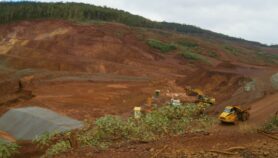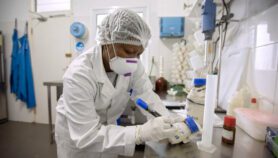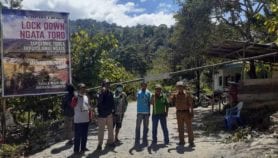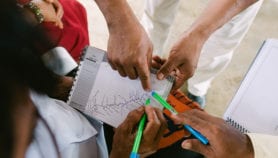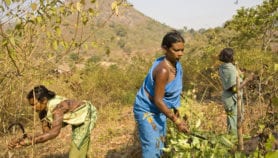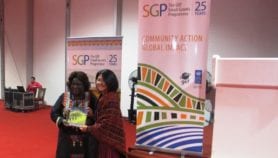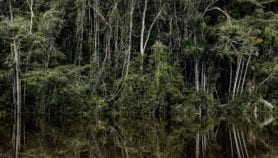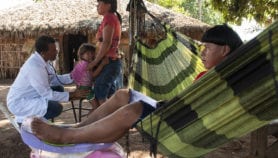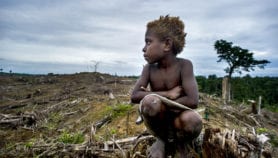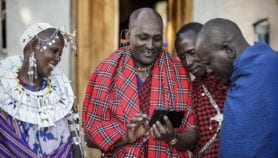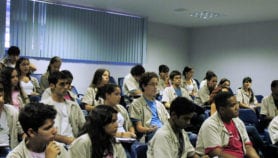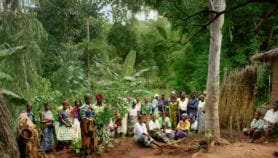By: Hannah Chalmers
Send to a friend
The details you provide on this page will not be used to send unsolicited email, and will not be sold to a 3rd party. See privacy policy.
Hannah Chalmers gives the low-down on how reducing emissions from deforestation can play a central role in tackling climate change.
According to the UN Department of Economic and Social Affairs, more than 1.6 billion people worldwide depend on forest resources for their livelihoods. [1] Forests also provide a range of ecosystem services, such as water storage, increased rainfall, nutrient recycling, biodiversity and soil stabilisation,and can help with flood control and boost agricultural productivity.
But as populations increase and countries develop, many forests have come under increasing stress — particularly in the developing world, where many countries are suffering from rapid deforestation (see Table 1).
|
Region |
Extent of forest in 2005 |
Annual change rate |
Annual change rate |
||||
|
Forest area |
Area (% of land area) |
Area per 1,000 people (ha) |
(1,000 ha) |
(% of land area) |
(1,000ha)
|
(% of land area) |
|
|
Africa |
635,412
|
21.4
|
673
|
-4,375
|
-0.64
|
-4,040
|
-0.62
|
|
Asia and the Pacific |
734,243
|
25.8
|
201
|
-1,275
|
-0.17
|
633
|
0.09
|
|
Europe |
1,001,394
|
44.3
|
1,369
|
877
|
0.09
|
661
|
0.07
|
|
Latin America and the Caribbean |
859,925
|
47.3
|
1,870
|
-4,147
|
-0.46
|
-4,483
|
-0.51
|
|
North America |
677,464
|
32.7
|
1,537
|
17
|
0.00
|
-101
|
-0.01
|
|
Western and Central Asia |
43,588
|
4.0
|
117
|
34
|
0.08
|
14
|
0.03
|
|
Total |
3,952,025
|
30.3
|
599
|
-8,868
|
-0.22
|
-7,317
|
-0.18
|
Table 1: Forest area and area change. [2]
Deforestation also has important implications for climate change (see Figure 1). It is estimated that deforestation accounts for around 20 per cent of global greenhouse gas emissions — more than that contributed by the whole transport sector. [4]
![Figure 1: Cumulative net flux of carbon to the atmosphere from changes in land use, 1950–2000 [3]](http://c96267.r67.cf3.rackcdn.com/co2fromlandusechange-409.gif)
![Figure 1: Cumulative net flux of carbon to the atmosphere from changes in land use, 1950–2000 [3]](http://c96267.r67.cf3.rackcdn.com/co2fromlandusechange_legend-409.gif)
![Figure 1: Cumulative net flux of carbon to the atmosphere from changes in land use, 1950–2000 [3]](http://c96267.r67.cf3.rackcdn.com/co2fromlandusechange_legend-409.gif)
![Figure 1: Cumulative net flux of carbon to the atmosphere from changes in land use, 1950–2000 [3]](http://c96267.r67.cf3.rackcdn.com/co2fromlandusechange_legend-409.gif)
Figure 1: Cumulative net flux of carbon to the atmosphere from changes in land use, 1950–2000 [3]
Deforestation in global climate negotiations
The value of afforestation (planting forests) was internationally recognised in 1997, when it was included in the Kyoto Protocol agreement on global action to reduce the risk of dangerous climate change. But decreasing deforestation and forest degradation has historically been absent from international negotiations because it is difficult to achieve.
In recent years, as negotiators work towards a new global deal to succeed the Kyoto Protocol when its first commitment period ends in 2012, tackling deforestation — particularly in the tropics — is back on the table as it is increasingly thought to be crucial for mitigating future climate change.
Proposals for integrating it into a post-2012 global climate deal have evolved over time. Initially the focus was on reducing emissions from deforestation (RED), but current negotiations are focusing on reducing emissions from deforestation and forest degradation (REDD). More recent suggestions include considering deforestation, degradation and the enhancement of forest carbon stocks (REDD-plus).
Table 2 summarises the development of REDD activities, including recent political moves, beginning with the first proposal in 2005.
|
Date |
Key activities |
|
December 2005 |
The Coalition of Rainforest Nations, led by Costa Rica and Papua New Guinea, propose a mechanism for RED in developing countries at the UN Framework Convention on Climate Change (UNFCCC) meeting in Montreal, Canada. The proposal |
|
May 2006 |
Based on information submitted by UNFCCC parties, the international community starts considering how to include the proposal in future negotiations, at a meeting of the Subsidiary Body on Scientific and Technological Advice (SBSTA). |
|
August 2006 |
First UNFCCC workshop on RED in developing countries is held in Rome, Italy. Participants discuss scientific issues as well as policy approaches. |
|
October 2006 |
The Stern Review on the economics of climate change recommends that "avoided deforestation measures" should be included in global climate policy. |
|
September 2007 |
Australia and Indonesia establish the Kalimantan Forests and Climate Partnership |
|
December 2007 |
REDD measures are officially recognised as potential nationally appropriate mitigation actions (NAMAs) that may be included in post-2012 climate policy at the UNFCCC talks in Bali, Indonesia. The agreed Bali Action Plan |
|
April 2008 |
Negotiations on REDD are now undertaken within the UNFCCC’s Ad Hoc Working Group on Long-term Cooperative Action as well as SBSTA. |
|
June 2008 |
The World Bank’s Forest Carbon Partnership Facility (FCPF) becomes operational to provide funds to help developing countries prepare for, evaluate and test REDD activities. The Congo Basin Forest Fund (CBFF) is established to reduce deforestation in the Congo Basin by improving local communities’ capacity for forest management. Initially financed by a grant of £100 million (US$165 million) from the British and Norwegian governments, the CBFF is intended as a multi-donor fund. The UNFCCC holds a workshop in Tokyo, Japan, on methodological issues related to REDD. The meeting emphasises the need for robust and cost-effective methods to estimate changes in forest cover and carbon stocks, as well as the need to improve developing countries’ technical capacities to implement them. |
|
July 2008 |
The UN-REDD programme is established to support international dialogue on including REDD in a post-2012 climate regime. It is a joint initiative of the UN Environment Programme (UNEP), the UN Development Programme (UNDP) and the UN Food and Agriculture Organization (FAO). |
|
August 2008 |
Brazil establishes an international fund to finance reduced deforestation in the Amazon, aiming to raise as much as US$21 billion by 2021. An initial pledge of US$100 million is made by Norway. |
|
December 2008 |
The UNFCCC holds climate talks in Poznan, Poland. There was much discussion about REDD in side events and outside the formal UN process, but little progress in the negotiations themselves. |
|
April 2009 |
Indigenous representatives across the world sign The Anchorage Declaration on climate change, emphasising the need for international climate negotiations to engage indigenous people and respect their rights, including in any agreed REDD initiatives. The concept of REDD-plus, which includes the role of conservation and enhancement of forest carbon stocks, is discussed at the UNFCCC climate talks in Bonn, Germany. |
|
June 2009 |
African environment ministers aim to adopt the Nairobi Declaration on climate |
|
December 2009 |
The UNFCCC will hold climate talks in Copenhagen, Denmark. The Bali Action Plan requires that a global agreement for a post-2012 international framework be reached at these talks. For REDD, this includes agreeing methodologies to allow it to be included in carbon accounting and trading systems. |
Table 2: REDD political landmarks in global climate negotiations. [4-6]
REDD for development
If REDD measures can be deployed successfully, they should provide a valuable opportunity for developing countries to lower their carbon emissions while reaping benefits such as biodiversity conservation and improved livelihoods.
Some initial projects are already demonstrating REDD’s potential for meeting development goals. One example is the work of the Amazonas Sustainable Foundation (FAS) in Brazil. [7] Its Bolsa Floresta programme, developed with local communities in the Amazon, values and compensates indigenous peoples for their role in conservingthe forest. According to FAS, by 2008, Bolsa Floresta had paid monthly rewards to nearly 5,000 families.
FAS also helps to manage the Juma reserve — established by the government of the state of Amazonas in 2006 and comprising nearly 600,000 hectares of Amazonian forest — as a RED project in which deforestation monitoring and control will be funded by selling credits. The Juma project is expected to prevent the deforestation of more than 360,000 hectares of tropical forest and the associated release of more than 200 million tons of carbon dioxide. [7]
One size doesn’t fit all
But the success of such projects does not guarantee that REDD can be quickly or easily applied elsewhere. The basic principle of REDD — that countries should be compensated for reducing emissions from deforestation — may be simple, but developing robust and equitable methodologies for implementing it is not.
A major hurdle is the wide variation between countries eligible for REDD, ranging from high forest cover combined with high deforestation, as is the case in much of South-East Asia, to low forest cover and low deforestation, as seen in South Asia and some areas of Sub-Saharan Africa. [5]
These varying circumstances mean that individual countries have very different views on what attributes would make a REDD support mechanism successful. Countries with historically high deforestation rates, for example, would gain most from a REDD mechanism that uses historical baselines instead of projected ones. In contrast, countries with low forest cover and low deforestation rates may not benefit from any REDD mechanism unless it also includes activities that enhance carbon stocks.
The 3E criteria
Researchers at the Center for International Forestry Research (CIFOR) in Indonesia have identified some of the problems facing scientists and negotiators seeking to implement REDD activities, framing their discussion within what is known as the "3E criteria": carbon effectiveness, cost efficiency, and equity and co-benefits. [8]
In assessing whether REDD can effectively reduce greenhouse gas emissions, a significant hurdle is simply monitoring and verifying changes in forest cover, especially with respect to degradation. Baselines for determining how much climate-mitigation benefit can be credited to any one project are needed, along with methods to assess whether changes attributed to REDD are permanent — so REDD credits aren’t given just for a delay in deforestation or forest degradation — and to determine whether a successful REDD project in one region simply leads to deforestation or forest degradation in another.
The cost-effectiveness of REDD activities will depend on the costs of monitoring, reporting and verification, as well as the costs of implementing policies and opportunity cost payments, where land users are paid to forgo alternative land uses. Some researchers have found that, although opportunity costs may be low, many developing countries are likely to require significant investment in capacity building, science, policy and institutions before they can implement REDD (see ‘What are the real costs of reducing forest emissions?‘). The World Resources Institute in Washington has highlighted the need to explore methods for the sustainable funding of REDD projects and other positive incentives for successful implementation. [9]
In assessing equity and co-benefit issues, it is widely recognised that REDD can reduce poverty, improve forest governance and help conserve biodiversity. But this will depend largely on how REDD projects are implemented. Some scientists argue that REDD is too limited in scope and that it would be better to value forests for all their ecosystem services, not just carbon. Others have raised concerns over the potential treatment of indigenous people and local communities in REDD projects, and options to facilitate their involvement in decision-making are being proposed by a range of stakeholders, including indigenous communities themselves. [10]
An emerging consensus
There is a wide range of opinions on how REDD could and should work.In addition to the countries that are eligible for REDD, other stakeholders are submitting proposals to the UNFCCC or otherwise contributing to the debate, including developed countries signed up to the Kyoto Protocol who may wish to trade REDD credits, and many nongovernmental organisations.
Any global framework must be flexible enough to accommodate different countries’ needs. This includes recognising countries’ different stages of development and their capacity to monitor, report on and verify REDD activities.
But although flexibility is important, a general framework will need to be agreed before REDD can be accepted into a global climate change agreement at Copenhagen. This is likely to include a three-phase approach comprising:
- national REDD strategy development, including national dialogue, institutional strengthening and demonstration activities;
- implementation of policies and measures from national strategies;
- and payment for performance based on quantified forest emissions and removals compared to agreed reference levels. [5]
Table 3 summarises a range of other aspects that must also be addressed before a final strategy can be adopted. Although some of these present technical difficulties, most will also be political issues too. For example, setting baselines has a technical element — how to realistically predict future deforestation and degradation in a business-as-usual scenario — but also has implications for what benefits a country will receive, as baselines will determine the level at which a country should start to be credited for emissions reductions. [8]
|
Issue |
Questions |
Options |
Emerging consensus |
|
Scope |
Which activities are eligible? |
Reducing emissions from deforestation (RED), reducing emissions from deforestation and degradation (REDD), or reducing emissions from deforestation and degradation and enhancement of carbon stocks (REDD-plus) |
Only developing countries should be allowed to participate. Mechanisms should include deforestation and degradation aspects, although enhancement is gaining increasing support. The preference seems to be for phased approaches that start with deforestation and then bring in degradation and enhancement activities. |
|
Reference level |
At what scale should emissions reductions be calculated? And over what time period? |
Scale: sub-national, national or global. Reference period: historical baseline, historical adjusted baseline, or projected baseline |
There is a strong preference for national calculations, although this could affect some developing countries that do not have the capacity to create national carbon accounts. Most nongovernmental proposals prefer historical baselines, whereas most governmental proposals suggest historical baselines with a development adjustment factor. |
|
Distribution |
Where does the money go? Is there an additional mechanism to reward carbon stocks? |
Money: redistribute existing funds. Mechanism: additional financing through, for example, voluntary donations, auction revenues or a levy on activities such as shipping and aviation |
Relatively few proposals include redistribution measures. |
|
Financing |
Where does the money come from? Are there multiple funding streams? |
A voluntary fund, a carbon market, or a market-linked mechanism |
There is growing agreement that a phased approach that combines different funding sources for different aspects of REDD will be most likely to succeed. This would also allow different countries to use different mechanisms according to their development status and other needs. |
Table 3: Key issues to be considered in REDD methodologies (based on analysis of 32 proposals in [5]).
The road to Copenhagen
Although REDD is not yet formally established in the UNFCCC framework, some REDD credits are already being sold in voluntary markets and some initial finance is provided for pilot projects. The World Bank’s Forest Carbon Partnership Facility includes a readiness mechanism to help governments participate in REDD. In particular, it helps developing countries estimate their forest carbon stocks, establish national reference scenarios, calculate opportunity costs, and design monitoring, reporting and verification systems. By September 2008, 14 tropical and subtropical countries were making use of the facility. [6]
The formal UN-REDD programme has also been established with six projects and a total approved budget of more than US$25 million and commitments to date (May 2009) of US$52 million. This programme will initially fund pilot projects to assess whether "carefully structured payment structures and capacity support can create the incentives to ensure actual, lasting, achievable, reliable and measurable emission reductions while maintaining and improving the other ecosystem services forests provide." [11]
Despite this, the future of REDD remains uncertain. As the period for delivering the Bali Action Plan draws to a close, it is not yet clear what will be agreed when future global action on the response to the risk of dangerous climate change is discussed in Copenhagen.
The importance of identifying approaches to mitigate carbon emissions from deforestation and forest degradation is firmly on the agenda. But it is not yet clear whether it will be possible to develop a robust REDD methodology that can provide effective emissions reductions that are cost effective, equitable and supported by sustainable financing options.
The contribution of scientists and engineers in developing robust technical solutions, implementing pilot projects and informing the political debate could — and should — play a critical role in shaping the eventual outcome.
Hannah Chalmers is a researcher in the Energy Technology for Sustainable Development Group at Imperial College London and climate change and energy consultant for SciDev.Net.
References
[1] Forests: The green and REDD of climate change ![]()
![]()
![]()
![]()
![]()
[2] State of the World’s Forests. FAO (2009)
[3] Carbon Emissions from Land Use, 1950 to 2000. World Resources Institute (2003)
[4] Stern, N. Stern Review on the Economics of Climate Change. HM Treasury (2006)
[5] Parker, C. et al. Little REDD+ book. Global Canopy Programme (2008)
[6] Tauli-Corpuz, V. et al. Guide on climate change and indigenous peoples ![]()
![]()
![]()
![]()
![]()
[7] Amazonas Sustainable Foundation. (2009)
[8] Angelsen, A. (ed.) Moving ahead with REDD: Issues, options and implications ![]()
![]()
![]()
![]()
![]()
[9] Daviet, F. Beyond carbon financing: The role of sustainable development policies and measures in REDD ![]()
![]()
![]()
![]()
![]()
[10] The Anchorage Declaration. Indigenous Peoples’ Global Summit on Climate Change (2009)
[11] UN-REDD Programme Fund. UNDP (2009)


